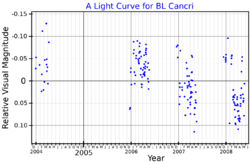Astronomy:Mu1 Cancri
| Observation data Equinox J2000.0]] (ICRS) | |
|---|---|
| Constellation | Cancer |
| Right ascension | 08h 06m 18.39542s[2] |
| Declination | +22° 38′ 07.7587″[2] |
| Apparent magnitude (V) | +5.99[3] (5.87–6.07)[4] |
| Characteristics | |
| Evolutionary stage | Asymptotic giant branch[5] |
| Spectral type | M3 III[6] |
| B−V color index | +1.66[3] |
| Variable type | Lb[6] |
| Astrometry | |
| Radial velocity (Rv) | +29.61±0.57[7] km/s |
| Proper motion (μ) | RA: −5.716[2] mas/yr Dec.: −9.696[2] mas/yr |
| Parallax (π) | 5.2029 ± 0.1702[2] mas |
| Distance | 630 ± 20 ly (192 ± 6 pc) |
| Absolute magnitude (MV) | −0.79[8] |
| Details | |
| Radius | 56.5+4.8 −5.2[2] R☉ |
| Luminosity | 565±21[2] L☉ |
| Temperature | 3,744+186 −150[2] K |
| Other designations | |
| Database references | |
| SIMBAD | data |
Mu1 Cancri, Latinised from μ1 Cancri, is a variable star in the zodiac constellation of Cancer. The name Mu1 comes from the Bayer naming system: the "1" in the name is because (from Earth) it appears to be close to 10 Cancri, or Mu2 Cancri. It is also known by the variable star designation BL Cancri. The star is dimly visible to the naked eye with an apparent visual magnitude that ranges from 5.87 down to 6.07.[4] Parallax measurements put it about 630 light-years (192 parsecs) from the Sun.[10] At that distance, the visual magnitude is diminished by an extinction factor of 0.28.[11] The position of the star near the ecliptic means it is subject to lunar occultations.[12]
The star Mu1 Cancri is an evolved red giant currently on the asymptotic giant branch[5] with a stellar classification of M3 III.[6] The lack of technetium-99 in the spectrum indicates it has not yet gone through third dredge-up.[13] It is a slow irregular variable[6] with thermal pulsation periods of 22.6, 37.8 and 203.7 days.[1] The star has expanded to 57 times the radius of the Sun and it is radiating 565 times the Sun's luminosity from its enlarged photosphere at an effective temperature of 3,774 K.[2]
References
- ↑ 1.0 1.1 "Long-term photometry and periods for 261 nearby pulsating M giants", Monthly Notices of the Royal Astronomical Society 400 (4): 1945–61, 2009, doi:10.1111/j.1365-2966.2009.15588.x, Bibcode: 2009MNRAS.400.1945T.
- ↑ 2.0 2.1 2.2 2.3 2.4 2.5 2.6 2.7 2.8 Brown, A. G. A. (August 2018). "Gaia Data Release 2: Summary of the contents and survey properties". Astronomy & Astrophysics 616: A1. doi:10.1051/0004-6361/201833051. Bibcode: 2018A&A...616A...1G. Gaia DR2 record for this source at VizieR.
- ↑ 3.0 3.1 Ducati, J. R. (2002), "VizieR Online Data Catalog: Catalogue of Stellar Photometry in Johnson's 11-color system", CDS/ADC Collection of Electronic Catalogues 2237, Bibcode: 2002yCat.2237....0D.
- ↑ 4.0 4.1 Samus', N. N; Kazarovets, E. V; Durlevich, O. V; Kireeva, N. N; Pastukhova, E. N (2017), "General catalogue of variable stars: Version GCVS 5.1", Astronomy Reports 61 (1): 80, doi:10.1134/S1063772917010085, Bibcode: 2017ARep...61...80S.
- ↑ 5.0 5.1 Eggen, Olin J. (July 1992), "Asymptotic giant branch stars near the sun", Astronomical Journal 104 (1): 275–313, doi:10.1086/116239, Bibcode: 1992AJ....104..275E.
- ↑ 6.0 6.1 6.2 6.3 Lebzelter, T.; Hron, J. (December 2003), "Technetium and the third dredge up in AGB stars. I. Field stars", Astronomy and Astrophysics 411 (3): 5335–42, doi:10.1051/0004-6361:20031458, Bibcode: 2003A&A...411..533L.
- ↑ de Bruijne, J. H. J.; Eilers, A.-C. (October 2012), "Radial velocities for the HIPPARCOS-Gaia Hundred-Thousand-Proper-Motion project", Astronomy & Astrophysics 546: 14, doi:10.1051/0004-6361/201219219, A61, Bibcode: 2012A&A...546A..61D.
- ↑ Anderson, E.; Francis, Ch. (2012), "XHIP: An extended hipparcos compilation", Astronomy Letters 38 (5): 331, doi:10.1134/S1063773712050015, Bibcode: 2012AstL...38..331A.
- ↑ "mu.01 Cnc". SIMBAD. Centre de données astronomiques de Strasbourg. http://simbad.u-strasbg.fr/simbad/sim-basic?Ident=mu.01+Cnc.
- ↑ van Leeuwen, F. (2007), "Validation of the new Hipparcos reduction", Astronomy and Astrophysics 474 (2): 653–664, doi:10.1051/0004-6361:20078357, Bibcode: 2007A&A...474..653V.
- ↑ Famaey, B. et al. (January 2005), "Local kinematics of K and M giants from CORAVEL/Hipparcos/Tycho-2 data. Revisiting the concept of superclusters", Astronomy and Astrophysics 430 (1): 165–186, doi:10.1051/0004-6361:20041272, Bibcode: 2005A&A...430..165F.
- ↑ Schneider, Glenn; Anderson, Chris (April 1993), "Rosemary Hill Observatory Lunar Occultation Summary for 1983-1984", Publications of the Astronomical Society of the Pacific 105: 367, doi:10.1086/133163, Bibcode: 1993PASP..105..367S.
- ↑ Lebzelter, T.; Hron, J. (December 2003), "Technetium and the third dredge up in AGB stars. I. Field stars", Astronomy and Astrophysics 411 (3): 533–542, doi:10.1051/0004-6361:20031458, Bibcode: 2003A&A...411..533L. See CncBL in Table 2.
 |


